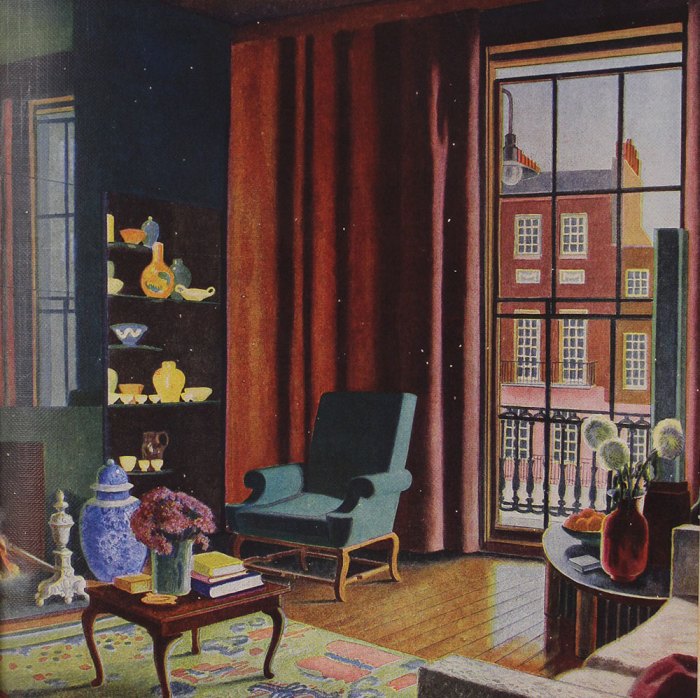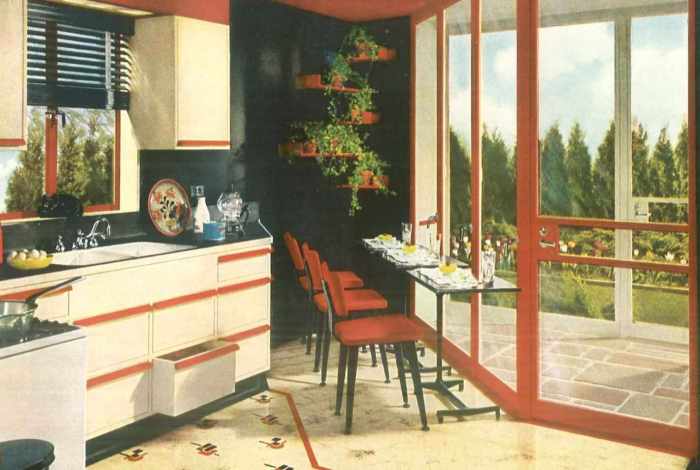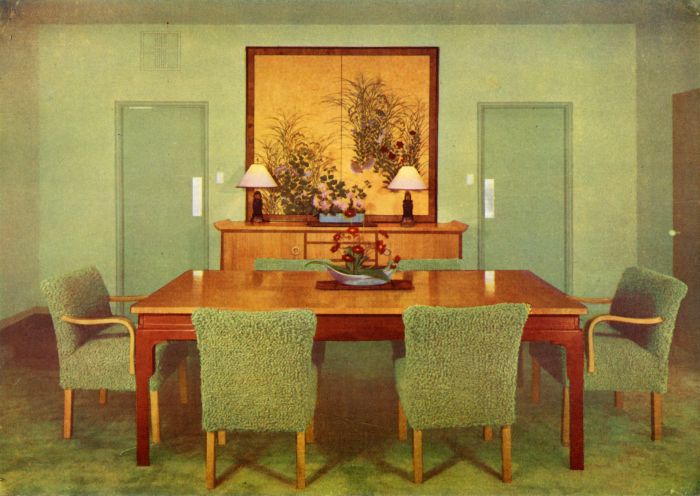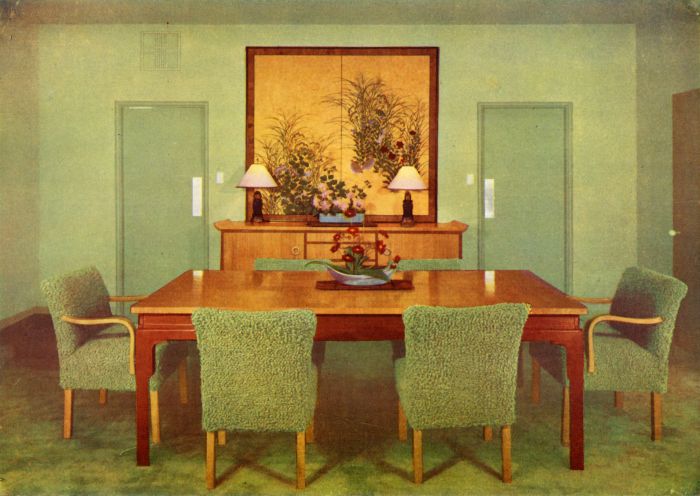1940 house interior design, a captivating blend of history and style, transports us to a bygone era of elegance and functionality. This period witnessed a fascinating shift in interior design trends, reflecting the social and economic changes that swept across the nation.
From the streamlined aesthetics of modernism to the enduring charm of traditional elements, 1940s homes offer a glimpse into a time when design was both practical and beautiful.
This article delves into the captivating world of 1940s interior design, exploring the key elements that defined this era. We will examine the dominant color palettes, materials, furniture, and decorative elements that characterized these homes, providing insights into the design principles and inspirations that shaped their unique aesthetic.
Historical Context
The 1940s was a pivotal decade marked by significant global events, including World War II. This period witnessed a transformation in architectural and interior design trends, reflecting the changing social and economic landscape. The war years brought about material shortages and a focus on practicality, while the postwar era saw a surge in suburban development and a renewed emphasis on comfort and style.
Architectural Styles of the 1940s
The 1940s saw a blend of traditional and modern architectural styles, influenced by the changing times. Some of the most prominent styles included:
- Traditional Styles:Colonial Revival, Tudor Revival, and Spanish Colonial remained popular, offering a sense of familiarity and stability in a turbulent world.
- Modern Styles:The International Style, characterized by clean lines, geometric forms, and the use of new materials like steel and glass, gained traction in the postwar era. This style reflected a shift towards modernism and functionality.
- Mid-Century Modern:This style emerged in the 1950s, drawing inspiration from the International Style but incorporating more organic shapes, warm woods, and vibrant colors. It became synonymous with the postwar suburban boom and the growing desire for comfortable and stylish living.
Economic and Social Conditions Influencing Interior Design
The economic and social conditions of the 1940s significantly shaped interior design trends. The war years brought about material shortages, leading to a focus on practicality and resourcefulness. People adapted to wartime conditions by repurposing furniture, using salvaged materials, and embracing simple, functional designs.After the war, the economic boom fueled a surge in suburban development, leading to a demand for affordable and comfortable homes.
Interior design trends reflected this shift, with a focus on creating inviting and functional spaces for families.
Iconic 1940s Houses and Interior Design Elements
The 1940s saw the rise of iconic homes that exemplified the architectural and interior design trends of the era. Some notable examples include:
- The Case Study Houses:This series of experimental homes, designed by leading architects in the 1940s and 1950s, showcased the potential of modern architecture and its integration with interior design. They featured open floor plans, large windows, and minimalist furnishings, reflecting the principles of the International Style.
- The Levittown Houses:This mass-produced suburban development, built in the 1950s, popularized the concept of affordable and standardized housing. The interiors of these homes typically featured simple, functional furniture, bright colors, and a focus on practicality.
- The Eichler Homes:These mid-century modern homes, designed by architect Joseph Eichler, featured open floor plans, large windows, and a connection to the outdoors. Their interiors often incorporated natural materials, such as wood and stone, and featured bold colors and geometric patterns.
“The 1940s was a decade of both hardship and innovation, and this duality is reflected in the architectural and interior design trends of the time.”
[Author’s Name]
Color Palette and Materials: 1940 House Interior Design

The 1940s saw a shift in interior design aesthetics, moving away from the opulent styles of the previous decades. This period embraced a more practical and functional approach, reflecting the wartime austerity and the growing influence of modernism. The color palettes and materials used in 1940s interiors were characterized by their simplicity, functionality, and connection to nature.
Dominant Color Palettes
The dominant color palettes of the 1940s were inspired by the natural world and the desire for a sense of calm and order. These palettes often incorporated muted and earthy tones, creating a sense of tranquility and sophistication.
- Warm Neutrals:Beige, cream, and ivory were popular choices for walls and furniture, creating a sense of warmth and spaciousness. These colors provided a neutral backdrop for pops of color in accents and accessories.
- Earthy Tones:Greens, browns, and blues inspired by nature were frequently used to bring a sense of the outdoors inside. These colors evoked a feeling of grounding and stability, reflecting the desire for a connection to nature during a time of uncertainty.
- Pastel Hues:Soft pinks, blues, and yellows were often used for accents and upholstery, adding a touch of femininity and lightheartedness to the space. These colors provided a sense of cheerfulness and optimism, offering a counterpoint to the somber realities of the war years.
Common Materials
The materials used in 1940s interiors were chosen for their durability, practicality, and affordability. This era saw a shift away from extravagant materials towards simpler and more functional options.
Furniture
- Wood:Solid wood, particularly oak, maple, and walnut, was a popular choice for furniture. These woods were known for their durability and timeless appeal, making them a wise investment for families looking for long-lasting pieces.
- Metal:Metal furniture, particularly steel and chrome, was gaining popularity in the 1940s, reflecting the influence of modernism. These materials offered a sleek and streamlined aesthetic, often seen in chairs, tables, and storage units.
- Cane and Wicker:Cane and wicker furniture offered a lightweight and airy aesthetic, perfect for creating a relaxed and inviting atmosphere. These materials were often used for chairs, armchairs, and occasional tables, adding a touch of rustic charm to the space.
Flooring
- Hardwood:Hardwood floors remained a popular choice for their durability and elegance. Oak, maple, and pine were common choices, offering a variety of colors and textures.
- Linoleum:Linoleum was a popular and affordable flooring option, known for its durability and ease of cleaning. It was often available in a variety of patterns and colors, allowing for a degree of personalization.
- Carpet:Carpets were often used in bedrooms and living rooms, adding warmth and comfort to the space. Wool carpets were particularly popular, offering a luxurious feel and excellent insulation.
Walls
- Plaster:Plaster walls were common in 1940s homes, offering a smooth and durable surface for painting or wallpapering.
- Wallpaper:Wallpaper was widely used in the 1940s, adding pattern and texture to the walls. Floral and geometric patterns were popular choices, reflecting the era’s love for nature and simplicity.
- Wood Paneling:Wood paneling, particularly in knotty pine, was often used to create a cozy and rustic atmosphere in living rooms and dens.
Upholstery
- Cotton:Cotton was a popular choice for upholstery, offering a comfortable and breathable fabric. It was often used for slipcovers and cushions, allowing for easy cleaning and changing of styles.
- Wool:Wool was another popular upholstery fabric, known for its durability and warmth. It was often used for heavier pieces, such as sofas and armchairs, adding a touch of luxury and elegance.
- Leather:Leather upholstery was becoming increasingly popular in the 1940s, offering a durable and sophisticated option for furniture. It was often used for armchairs and accent chairs, adding a touch of masculinity and timeless appeal.
Furniture and Decor
The 1940s were a time of transition in interior design, with the streamlined modern style gaining popularity alongside the enduring appeal of traditional designs. This era saw a shift in focus towards comfort, functionality, and a sense of practicality, reflecting the changing social landscape and economic realities of the time.
1940s house interior design often featured a blend of traditional and modern elements, with a focus on functionality and comfort. While many 1940s homes were smaller, the principles of efficient design can be applied to larger spaces as well.
For example, a 1300 square feet house interior design can embrace the streamlined aesthetics of the era by incorporating built-in storage, open floor plans, and a neutral color palette. This allows for a sense of spaciousness and a timeless elegance that resonates with the spirit of the 1940s.
Furniture Styles
The 1940s saw a blend of traditional and modern furniture styles, each reflecting the era’s unique aesthetic.
- Traditional Styles: Traditional styles like Queen Anne, Chippendale, and Georgian remained popular, offering a sense of timelessness and elegance. These styles featured intricate carvings, rounded forms, and a focus on craftsmanship.
- Mid-Century Modern: This style emerged in the 1940s and gained momentum in the 1950s. It emphasized clean lines, geometric shapes, and functional designs. Notable designers of this era include Eero Saarinen, Charles and Ray Eames, and George Nelson, who created iconic pieces like the “Tulip” chair, the “Eames Lounge Chair,” and the “Ball Clock.”
- Art Deco: Though originating in the 1920s, Art Deco continued to influence furniture design in the 1940s. It showcased bold geometric patterns, luxurious materials like chrome and leather, and a focus on ornamentation.
Decorative Elements
Decorative elements played a crucial role in shaping the ambiance of 1940s homes.
- Lamps: Lamps were essential for providing light and adding a decorative touch. Popular styles included table lamps with geometric bases, floor lamps with sleek designs, and pendant lights with simple, elegant forms.
- Rugs: Rugs were used to define spaces, add warmth, and introduce patterns and colors. Popular materials included wool, cotton, and silk, with designs ranging from traditional Persian motifs to abstract patterns.
- Artwork: Art played a significant role in enhancing the aesthetic appeal of 1940s homes. Popular genres included abstract art, landscapes, and still lifes, often featuring vibrant colors and bold compositions. Artwork was displayed on walls, shelves, and easels, adding a personal touch to the decor.
- Textiles: Textiles were used extensively in 1940s homes, adding color, texture, and warmth. Popular fabrics included cotton, linen, velvet, and wool, often used for upholstery, curtains, and throws.
Bedroom Design
The 1940s bedroom was a sanctuary, a space for rest and rejuvenation after a long day. The design aimed to create a tranquil and inviting atmosphere, reflecting the values of simplicity and functionality that were prevalent during this era.
Furniture and Textiles
The furniture in a 1940s bedroom was typically made from sturdy, durable materials like wood and metal. Simple, streamlined designs were preferred, often featuring rounded corners and smooth surfaces. A four-poster bed with a canopy was a popular choice, adding a touch of elegance and privacy.
Other common furniture pieces included a dresser, a vanity table, a nightstand, and a chaise lounge.Textiles played a significant role in creating a cozy and inviting ambiance. Natural fabrics like cotton, linen, and wool were favored for their breathability and comfort.
Bedspreads, curtains, and rugs often featured floral patterns, geometric designs, or solid colors in muted tones.
Lighting
Lighting in a 1940s bedroom was designed to be both functional and decorative. A central chandelier or pendant light provided general illumination, while bedside lamps with adjustable shades offered a softer, more intimate light for reading or relaxing. Wall sconces with fabric shades added a touch of elegance and ambiance.
1940s house interior design often featured simple, functional furniture with clean lines and a focus on comfort. This era embraced a sense of practicality, often incorporating elements of mid-century modern design. For those looking to achieve a similar aesthetic in a smaller space, consider exploring ideas for 1200 sq ft house interior design , where space optimization and efficient layouts are crucial.
Even with a smaller footprint, you can still capture the essence of 1940s design by incorporating classic pieces, neutral color palettes, and natural materials.
Creating a Sense of Tranquility and Comfort
The 1940s bedroom was a place for rest and relaxation. To create a sense of tranquility and comfort, designers focused on creating a calm and inviting atmosphere. Soft lighting, soothing colors, and comfortable furnishings were essential elements.
Period-Specific Accessories and Decor
Accessories and decor played a vital role in enhancing the overall aesthetic of a 1940s bedroom. Popular choices included:
- Framed photographs and artwork, often depicting landscapes or still lifes
- Vases filled with fresh flowers or dried arrangements
- Antique clocks and other decorative objects
- Bookshelves filled with books and magazines
- Throw pillows and blankets in coordinating fabrics
Bathroom Design
The bathroom in a 1940s home was a place of both practicality and style. While the focus was on functionality, design elements reflected the era’s aesthetic trends, showcasing a blend of traditional and modern elements.
Materials and Fixtures
The materials and fixtures used in a 1940s bathroom reflected the era’s emphasis on durability and functionality.
- Tile:Ceramic tile was a popular choice for bathroom floors and walls, offering both durability and ease of cleaning. Common patterns included geometric designs, floral motifs, and simple monochrome schemes.
- Tub and Shower:Cast iron tubs were standard, often featuring claw feet or pedestal designs. Showers were becoming more common, with tiled stalls or shower curtains becoming increasingly popular.
- Vanity:Vanities were typically made of wood, with a simple design and often featuring a built-in medicine cabinet.
- Hardware:Chrome or nickel hardware was common, with simple and streamlined designs.
- Lighting:Lighting fixtures were often simple and functional, with frosted glass globes or metal shades.
Color Schemes
The color palettes in 1940s bathrooms reflected the era’s taste for clean lines and understated elegance.
1940s house interior design often featured streamlined, modern furniture with a focus on functionality. While the square footage of a house might have been smaller back then, modern design principles can still be applied to contemporary homes. If you’re looking for inspiration for a smaller space, consider exploring the principles of 1350 sq ft house interior design which often prioritize maximizing space and natural light, echoing the design philosophy of the 1940s.
- Neutral Tones:White, cream, and pale gray were popular choices for walls and fixtures, creating a sense of spaciousness and cleanliness.
- Bold Accents:Bold colors like emerald green, deep blue, or terracotta were used sparingly as accents, often found in towels, rugs, or decorative accessories.
Visual Representation
Imagine a 1940s bathroom with white ceramic tile covering the walls and floor. A freestanding cast iron bathtub with claw feet sits in one corner, while a tiled shower stall with a glass door occupies the other. The vanity is made of wood with a simple design and features a built-in medicine cabinet with chrome hardware.
A chrome-plated showerhead hangs from the ceiling, and a simple, frosted glass globe light fixture illuminates the space. The overall color scheme is predominantly white, with touches of emerald green in the towels and bath mat.
Modern Influences

The 1940s witnessed a significant shift in interior design, with modernism emerging as a powerful force. This movement, characterized by its emphasis on streamlined forms, functionality, and clean lines, began to influence home interiors in a profound way. While traditional design elements remained popular, modernism offered a fresh perspective on how spaces could be designed and lived in.
The Impact of Modernism
Modernism’s influence on 1940s interior design was undeniable. The movement’s emphasis on functionality and simplicity resonated with a society grappling with the aftermath of World War II. People sought homes that were practical, efficient, and free from unnecessary ornamentation. This led to the adoption of streamlined forms, open floor plans, and the use of new materials like plastics and metal.
“The modern house should be a machine for living,” declared architect Le Corbusier, a key figure in the modern movement.
Comparing Traditional and Modern Styles
While traditional design principles emphasized ornate details, craftsmanship, and historical references, modernism embraced a more minimalist approach. Here’s a comparison:| Feature | Traditional Style | Modern Style ||—|—|—|| Form| Curvaceous, ornate, detailed | Streamlined, geometric, simple || Functionality| Less emphasis on functionality | Highly functional, efficient || Materials| Natural materials like wood, stone, and fabric | Synthetic materials like plastics, metal, and glass || Color Palette| Rich, warm colors | Neutral colors with pops of bright accents || Furniture| Ornate, heavy, handcrafted | Simple, lightweight, mass-produced |
Modern Design Principles in 1940s Interiors
Modern design principles were incorporated into 1940s interiors in various ways. Some notable examples include:* Streamlined Furniture:Furniture designs featured clean lines, geometric shapes, and a focus on functionality. Examples include the iconic Eames Lounge Chair and the Wassily Chair by Marcel Breuer.
Open Floor Plans
Modern homes often featured open floor plans that created a sense of spaciousness and fluidity. This allowed for a more flexible use of space and promoted a sense of openness.
Use of New Materials
The use of new materials like plastics, metal, and glass was embraced in modern design. These materials offered durability, affordability, and a modern aesthetic.
Neutral Color Palettes
Modern interiors often featured neutral color palettes, such as white, gray, and beige, which provided a clean backdrop for furniture and artwork. Pops of color were often introduced through accent pieces and accessories.
Regional Variations
The 1940s saw a diverse landscape of interior design styles, influenced by regional tastes and local traditions. From the coastal charm of California to the rustic elegance of the American South, each region brought its unique flair to home décor.
Regional Influences on Furniture Styles
The impact of regional variations was particularly evident in furniture styles. For instance, the Southwest region embraced the use of Native American-inspired furniture, characterized by intricate carvings, natural materials like leather and wood, and vibrant colors. This style often incorporated elements of Spanish Colonial design, reflecting the region’s history and cultural heritage.
In contrast, the East Coast favored more traditional furniture styles, drawing inspiration from European design trends. This included pieces with intricate details, rich fabrics, and a focus on craftsmanship.
Regional Influences on Materials and Decorative Elements
Regional variations extended to the materials and decorative elements used in homes. Coastal regions, like those along the Pacific coast, incorporated natural materials like driftwood, seashells, and nautical-themed accessories to create a relaxed and beachy vibe. In contrast, the Midwest favored rustic elements, such as wood-paneled walls, exposed beams, and farmhouse-style furniture, reflecting the region’s agricultural heritage.
The use of local materials, like stone and brick, also contributed to the distinct character of homes in different regions.
Regional Influences on Color Palettes
Color palettes also reflected regional preferences. The sunny climates of the Southwest inspired the use of warm earth tones, vibrant hues, and bold patterns. In contrast, the cooler climates of the Northeast favored more muted tones, such as blues, greens, and grays, creating a sense of tranquility and sophistication.
Examples of Regional Variations
- California:Coastal living influenced the use of light and airy color palettes, natural materials like rattan and wicker, and nautical accents.
- New England:Traditional furniture styles, rich fabrics, and a focus on craftsmanship were prevalent, reflecting the region’s historical ties to Europe.
- The South:Rustic elegance was achieved through the use of wood-paneled walls, exposed beams, and farmhouse-style furniture, reflecting the region’s agricultural heritage.
- The Midwest:Homes featured a blend of traditional and modern elements, with a focus on functionality and comfort.
- The Southwest:Native American and Spanish Colonial influences resulted in the use of vibrant colors, intricate carvings, and natural materials like leather and wood.
Contemporary Interpretation

The 1940s, a period marked by wartime austerity and a burgeoning postwar optimism, produced a distinct interior design aesthetic. Today, this style continues to inspire contemporary designers, who seamlessly blend its key elements with modern sensibilities.
Incorporating 1940s Elements in Modern Spaces
Contemporary designers reinterpret 1940s design principles to create spaces that are both stylish and functional. Here’s how:
- Streamlined Forms:The emphasis on functionality and clean lines characteristic of the 1940s resonates with contemporary design principles. Modern designers often incorporate furniture with simple, geometric shapes, like mid-century modern pieces with their iconic curves and clean lines.
- Warm Color Palettes:The muted yet inviting color palettes of the 1940s, often featuring shades of beige, gray, and blue, are reinterpreted in contemporary spaces. These colors create a sense of calm and sophistication, a stark contrast to the vibrant hues often seen in modern interiors.
- Natural Materials:The use of natural materials like wood, leather, and linen, prevalent in 1940s design, remains popular today. These materials add warmth and texture to contemporary spaces, while their sustainability aligns with modern design values.
- Statement Lighting:The iconic pendant lights and floor lamps of the 1940s, often featuring brass or chrome accents, are still highly sought after. Contemporary designers use these pieces to create a focal point in a room, adding a touch of vintage charm to modern spaces.
Challenges and Opportunities, 1940 house interior design
Blending vintage aesthetics with modern functionality presents unique challenges and opportunities.
- Maintaining Functionality:The focus on practicality in 1940s design is often at odds with the open floor plans and minimalist aesthetics of contemporary spaces. Designers must carefully curate vintage pieces to ensure they complement modern functionality, avoiding clutter and maximizing space utilization.
- Balancing Tradition and Innovation:The challenge lies in finding the right balance between traditional 1940s design elements and modern innovations. This might involve using vintage furniture pieces alongside modern lighting fixtures, or incorporating traditional patterns in contemporary textiles.
- Sustainability and Upcycling:The use of sustainable materials and upcycled vintage pieces aligns with contemporary design principles. Designers can source antique furniture and revitalize it with modern finishes, breathing new life into vintage pieces while adhering to sustainable practices.
Contemporary Spaces with 1940s Design Elements
Contemporary spaces featuring 1940s design elements are not uncommon.
- Modern Homes:Modern homes often incorporate vintage furniture pieces like mid-century modern armchairs, vintage coffee tables, or retro lighting fixtures. These elements add a touch of character and nostalgia to the otherwise minimalist interiors.
- Commercial Spaces:Restaurants, cafes, and hotels often incorporate 1940s design elements to create a vintage-inspired atmosphere. This might involve using warm color palettes, wood paneling, and vintage furniture to evoke a sense of nostalgia and sophistication.
- Art Deco Revival:The Art Deco movement, which was influential in the 1940s, is experiencing a revival in contemporary design. Designers are reinterpreting Art Deco motifs and geometric patterns in modern furniture, textiles, and accessories.
Final Wrap-Up
The allure of 1940 house interior design lies in its ability to seamlessly blend functionality with timeless elegance. By understanding the historical context, design principles, and regional variations, we can appreciate the enduring appeal of this era. Whether you’re seeking inspiration for your own home renovation or simply fascinated by the evolution of interior design, the 1940s offer a wealth of ideas and a glimpse into a captivating era.
FAQ Section
What are some common colors used in 1940s interiors?
Popular colors included muted pastels like pale blue, green, and yellow, along with warm neutrals like beige and brown. Bold accent colors like red and navy blue were also used to add pops of vibrancy.
What are some key features of 1940s furniture?
Furniture from this era often featured streamlined forms, rounded edges, and simple silhouettes. Popular styles included Art Deco, Mid-Century Modern, and traditional pieces with a modern twist.
How can I incorporate 1940s design elements into my modern home?
You can introduce vintage furniture pieces, incorporate a muted color palette, and use decorative elements like geometric patterns and mid-century lamps to achieve a contemporary interpretation of 1940s style.

